Module 6: Organizing and Outlining Your Speech
Methods of speech delivery, learning objectives.
Identify the four types of speech delivery methods and when to use them.
There are four basic methods of speech delivery: manuscript, memorized, impromptu, and extemporaneous. We’ll look at each method and discuss the advantages and disadvantages of each.

A manuscript page from President George W. Bush’s address to the nation on the day of the 9/11 attacks in 2001.
A manuscript speech is when the speaker writes down every word they will speak during the speech. When they deliver the speech, they have each word planned and in front of them on the page, much like a newscaster who reads from a teleprompter.
The advantage of using a manuscript is that the speaker has access to every word they’ve prepared in advance. There is no guesswork or memorization needed. This method comforts some speakers’ nerves as they don’t have to worry about that moment where they might freeze and forget what they’ve planned to say. They also are able to make exact quotes from their source material.
When the exact wording of an idea is crucial, speakers often read from a manuscript, for instance in communicating public statements from a company.
However, the disadvantage with a manuscript is that the speakers have MANY words in front of them on the page. This prohibits one of the most important aspects of delivery, eye contact. When many words are on the page, the speakers will find themselves looking down at those words more frequently because they will need the help. If they do look up at the audience, they often cannot find their place when the eye returns to the page. Also, when nerves come into play, speakers with manuscripts often default to reading from the page and forget that they are not making eye contact or engaging their audience. Therefore, manuscript is a very difficult delivery method and not ideal. Above all, the speakers should remember to rehearse with the script so that they practice looking up often.

Public Speaking in History
The fall of the Berlin Wall on November 9, 1989, owed in large part to a momentary error made by an East German government spokesperson. At a live press conference, Günter Schabowski tried to explain new rules relaxing East Germany’s severe travel restrictions. A reporter asked, “when do these new rules go into effect?” Visibly flustered, Schabowski said, “As far as I know, it takes effect immediately, without delay.” In fact, the new visa application procedure was supposed to begin the following day, and with a lot of bureaucracy and red tape. Instead, thousands of East Berliners arrived within minutes at the border crossings, demanding to pass through immediately. The rest is history.
The outcome of this particular public-relations blunder was welcomed by the vast majority of East and West German citizens, and hastened the collapse of communism in Eastern and Central Europe. It’s probably good, then, that Schabowski ran this particular press conference extemporaneously, rather than reading from a manuscript.
You can view the transcript for “The mistake that toppled the Berlin Wall” here (opens in new window) .
A memorized speech is also fully prepared in advance and one in which the speaker does not use any notes. In the case of an occasion speech like a quick toast, a brief dedication, or a short eulogy, word-for-word memorization might make sense. Usually, though, it doesn’t involve committing each and every word to memory, Memorizing a speech isn’t like memorizing a poem where you need to remember every word exactly as written. Don’t memorize a manuscript! Work with your outline instead. Practice with the outline until you can recall the content and order of your main points without effort. Then it’s just a matter of practicing until you’re able to elaborate on your key points in a natural and seamless manner. Ideally, a memorized speech will sound like an off-the-cuff statement by someone who is a really eloquent speaker and an exceptionally organized thinker!
The advantage of a memorized speech is that the speaker can fully face their audience and make lots of eye contact. The problem with a memorized speech is that speakers may get nervous and forget the parts they’ve memorized. Without any notes to lean on, the speaker may hesitate and leave lots of dead air in the room while trying to recall what was planned. Sometimes, the speaker can’t remember or find his or her place in the speech and are forced to go get the notes or go back to the PowerPoint in some capacity to try to trigger his or her memory. This can be an embarrassing and uncomfortable moment for the speaker and the audience, and is a moment which could be easily avoided by using a different speaking method.
How to: memorize a speech
There are lots of tips out there about how to memorize speeches. Here’s one that loosely follows an ancient memorization strategy called the method of loci or “memory palace,” which uses visualizations of familiar spatial environments in order to enhance the recall of information.
You can view the transcript for “How to Memorize a Speech” here (opens in new window) .
An impromptu speech is one for which there is little to no preparation. There is often not a warning even that the person may be asked to speak. For example, your speech teacher may ask you to deliver a speech on your worst pet peeve. You may or may not be given a few minutes to organize your thoughts. What should you do? DO NOT PANIC. Even under pressure, you can create a basic speech that follows the formula of an introduction, body, and conclusion. If you have a few minutes, jot down some notes that fit into each part of the speech. (In fact, the phrase “speaking off the cuff,” which means speaking without preparation, probably refers to the idea that one would jot a few notes on one’s shirt cuff before speaking impromptu.) [1] ) An introduction should include an attention getter, introduction of the topic, speaker credibility, and forecasting of main points. The body should have two or three main points. The conclusion should have a summary, call to action, and final thought. If you can organize your thoughts into those three parts, you will sound like a polished speaker. Even if you only hit two of them, it will still help you to think about the speech in those parts. For example, if a speech is being given on a pet peeve of chewed gum being left under desks in classrooms, it might be organized like this.
- Introduction : Speaker chews gum loudly and then puts it under a desk (attention getter, demonstration). Speaker introduces themselves and the topic and why they’re qualified to speak on it (topic introduction and credibility). “I’m Katie Smith and I’ve been a student at this school for three years and witnessed this gum problem the entire time.”
- Body : Speaker states three main points of why we shouldn’t leave gum on desks: it’s rude, it makes custodians have to work harder, it affects the next student who gets nastiness on their seat (forecast of order). Speaker then discusses those three points
- Conclusion : Speaker summarizes those three points (summary, part 1 of conclusion), calls on the audience to pledge to never do this again (call to action), and gives a quote from Michael Jordan about respecting property (final thought).
While an impromptu speech can be challenging, the advantage is that it can also be thrilling as the speaker thinks off the cuff and says what they’re most passionate about in the moment. A speaker should not be afraid to use notes during an impromptu speech if they were given any time to organize their thoughts.
The disadvantage is that there is no time for preparation, so finding research to support claims such as quotes or facts cannot be included. The lack of preparation makes some speakers more nervous and they may struggle to engage the audience due to their nerves.
Extemporaneous
The last method of delivery we’ll look at is extemporaneous. When speaking extemporaneously, speakers prepare some notes in advance that help trigger their memory of what they planned to say. These notes are often placed on notecards. A 4”x6” notecard or 5”x7” size card works well. This size of notecards can be purchased at any office supply store. Speakers should determine what needs to go on each card by reading through their speech notes and giving themselves phrases to say out loud. These notes are not full sentences, but help the speakers, who turn them into a full sentence when spoken aloud. Note that if a quote is being used, listing that quote verbatim is fine.
The advantage of extemporaneous speaking is that the speakers are able to speak in a more conversational tone by letting the cards guide them, but not dictate every word they say. This method allows for the speakers to make more eye contact with the audience. The shorter note forms also prevent speakers from getting lost in their words. Numbering these cards also helps if one gets out of order. Also, these notes are not ones the teacher sees or collects. While you may be required to turn in your speech outline, your extemporaneous notecards are not seen by anyone but you. Therefore, you can also write yourself notes to speak up, slow down, emphasize a point, go to the next slide, etc.
The disadvantage to extemporaneous is the speakers may forget what else was planned to say or find a card to be out of order. This problem can be avoided through rehearsal and double-checking the note order before speaking.
Many speakers consider the extemporaneous method to be the ideal speaking method because it allows them to be prepared, keeps the audience engaged, and makes the speakers more natural in their delivery. In your public speaking class, most of your speeches will probably be delivered extemporaneously.
- As per the Oxford English Dictionary' s entry for "Off the Cuff." See an extensive discussion at Mark Liberman's Language Log here: https://languagelog.ldc.upenn.edu/nll/?p=4130 ↵
- Method of loci definition. Provided by : Wikipedia. Located at : https://en.wikipedia.org/wiki/Method_of_loci . License : CC BY-SA: Attribution-ShareAlike
- The mistake that toppled the Berlin Wall. Provided by : Vox. Located at : https://youtu.be/Mn4VDwaV-oo . License : Other . License Terms : Standard YouTube License
- How to Memorize a Speech. Authored by : Memorize Academy. Located at : https://youtu.be/rvBw__VNrsc . License : Other . License Terms : Standard YouTube License
- Address to the Nation. Provided by : U.S. National Archives. Located at : https://prologue.blogs.archives.gov/2011/09/06/911-an-address-to-the-nation/ . License : Public Domain: No Known Copyright
- Methods of Speech Delivery. Authored by : Misti Wills with Lumen Learning. License : CC BY: Attribution


5 Ways of Delivering Speeches
Understanding Delivery Modes
In this chapter . . .
In this chapter, we will explore the three modes of speech delivery: impromptu, manuscript, and extemporaneous. Each offers unique advantages and potential challenges. An effective public speaker needs to be familiar with each style so they can use the most appropriate mode for any speech occasion.
In writing, there’s only one way of delivering the text: the printed word on a page. Public Speaking, however, gives you different ways to present your text. These are called the delivery modes , or simply, ways of delivering speeches. The three modes are impromptu delivery , manuscript delivery , and extemporaneous delivery . Each of these involves a different relationship between a speech text, on the one hand, and the spoken word, on the other. These are described in detail below.
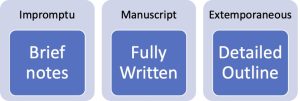
Impromptu Delivery
Impromptu speaking is a short form speech given with little to no preparation. While being asked to stand in front of an audience and deliver an impromptu speech can be anxiety-producing, it’s important to remember that impromptu speaking is something most people do without thinking in their daily lives . If you introduce yourself to a group, answer an open-ended question, express an opinion, or tell a story, you’re using impromptu speaking skills. While impromptus can be stressful, the more you do it the easier it becomes.
Preparation for Impromptu Delivery
The difficulty of impromptu speaking is that there is no way to prepare, specifically, for that moment of public speaking. There are, however, some things you can do to stay ready in case you’re called upon to speak unrehearsed.
For one, make sure your speaking instruments (your voice and body) are warmed up, energized, and focused. It could be helpful to employ some of the actor warm-up techniques mentioned earlier as part of an everyday routine. If appropriate to the impromptu speaking situation, you could even ask to briefly step aside and warm yourself up so that you feel relaxed and prepared.
Furthermore, a good rule when brainstorming for an impromptu speech is that your first idea is your best. You can think about impromptu speaking like improvisation: use the “yes, and” rule and trust your instincts. You’ll likely not have time to fully map out the speech, so don’t be too hard on yourself to find the “perfect” thing to say. You should let your opinions and honest thoughts guide your speaking. While it’s easy to look back later and think of approaches you should have used, try to avoid this line of thinking and trust whatever you come up with in the moment.
Finally, as you prepare to speak, remind yourself what your purpose is for your speech. What is it that you hope to achieve by speaking? How do you hope your audience feels by the end? What information is most important to convey? Consider how you’ll end your speech. If you let your purpose guide you, and stay on topic throughout your speech, you’ll often find success.
Delivery of Impromptu Speeches
Here is a step-by-step guide that may be useful if you’re called upon to give an impromptu speech:
- Thank the person for inviting you to speak. Don’t make comments about being unprepared, called upon at the last moment, on the spot, or uneasy.
- Deliver your message, making your main point as briefly as you can while still covering it adequately and at a pace your listeners can follow.
- Stay on track. If you can, use a structure, using numbers if possible: “Two main reasons . . .” or “Three parts of our plan. . .” or “Two side effects of this drug. . .” Past, present, and future or East Coast, Midwest, and West Coast are common structures.
- Thank the person again for the opportunity to speak.
- Stop talking when you are finished (it’s easy to “ramble on” when you don’t have something prepared). If in front of an audience, don’t keep talking as you move back to your seat. Finish clearly and strong.
Impromptu speeches are most successful when they are brief and focus on a single point.
Another helpful framing technique for impromptus is to negate the premise. This is the deliberate reframing of a given prompt in a way that acknowledges the original but transitions into talking about the topic in a different way than expected. Negating the premise can be an effective rhetorical technique if used carefully and can help you focus your response on a topic that you’re interested in talking about.
If you suddenly run out of things to say in the middle of your speech, be open to pivoting . Giving another example or story is the easiest way to do this. What’s important is to not panic or allow yourself to ramble aimlessly. No matter what, remember to keep breathing.
Finally, the greatest key to success for improving impromptu speaking is practice. Practice speaking without rehearsal in low-stakes environments if you can (giving a toast at a family dinner, for example). But remember this: no one is expecting the “perfect” speech if you’re called upon to speak impromptu. It’s okay to mess up. As Steven Tyler of the rock band Aerosmith would say: dare to suck. Take a risk and make a bold choice. What is most important is to stay sure of yourself and your knowledge.
Manuscript Delivery
The opposite of an impromptu speech is the manuscript speech. This involves having the complete text of your speech written out on paper or on notecards. You may be reading the speech from a computer or a teleprompter. In some cases, the speaker memorizes this manuscript.
Manuscript delivery is the word-for-word iteration of a written message. In a manuscript speech, the speaker maintains their attention on the printed page except when using visual aids. The advantage of reading from a manuscript is the exact repetition of original words. In some circumstances, this can be extremely important.
Advantages & Disadvantages to Manuscript Delivery
There are many advantages in speaking from a manuscript. Some people find they are less nervous when they have the whole text in front of them. If you get lost or flustered during the speech you can glance down and get back on track. For speakers who struggle with vocalized pauses, it can be easier to know exactly what you want to say so that you’re not searching for the right word. Some people prefer to carefully craft the language of their speech instead of just having a sense of the main point and expounding upon it. Particularly if there are a lot of statistics or quotations, it can be helpful to have the whole passage written out to make sure you not only convey it correctly but frame it in the right context. It’s also easier to rehearse and time a manuscript speech, thus making sure it stays within time limits and isn’t unexpectedly too short or long. For some formal occasions or events that may be emotional for the speaker, such as a funeral, using a manuscript may be the best approach.
There are some disadvantages in delivering a speech from a manuscript. Having a manuscript in front of you often encourages looking down and reading the speech instead of performing it. A lack of eye contact makes the audience feel less engaged. The speech can feel stilted and lacking energy. Some speakers may feel constrained and that they can’t deviate from their script. Furthermore, while some find it easier to find their place with a quick glance down having the full manuscript, others find it difficult to avoid losing their place. If you go off script it can be harder to recover.
Successful Manuscript Delivery
A successful manuscript delivery requires a dynamic performance that includes lots of eye contact, animated vocals, and gestures. This can only be accomplished if you’re very familiar with the manuscript. Delivering a manuscript that you have written but only spoken aloud once before delivery will most often result in stumbling over words and eyes locked to the page. You’ll be reading aloud at your audience, instead of speaking to them. Remember what it’s like in school when a teacher asks a student to stand up and read something aloud? If the student isn’t familiar with the text, it can be a struggle both for the reader and the audience.
The key to avoiding this problem is to practice your written speech as much as you can, at least five or six times. You want to get so familiar with your speech that you can take your eyes off the page and make frequent eye contact with your audience. When you’re very familiar with your speech, your tone of speaking becomes more conversational. The text flows more smoothly and you begin to sound like a speaker, not a reader. You can enjoy the presentation and your audiences will enjoy it as well.
To improve your skills at manuscript delivery, practice reading written content aloud. This allows you to focus exclusively on delivery instead of worrying about writing a speech first. In particular, reading dialogue or passages from theatre plays, film/television scripts, or books provides material that is intended to be expressive and emotive. The goal is to deliver the content in a way that is accessible, interesting, alive, and engaging for the audience.
To Memorize or Not to Memorize
One way to overcome the problem of reading from the page is to memorize your word-for-word speech. When we see TED Talks, for example, they are usually memorized.
Memorized speaking is the delivery of a written message that the speaker has committed to memory. Actors, of course, recite from memory whenever they perform from a script. When it comes to speeches, memorization can be useful when the message needs to be exact, and the speaker doesn’t want to be confined by notes.
The advantage to memorization is that it enables the speaker to maintain eye contact with the audience throughout the speech. However, there are some real and potential costs. Obviously, memorizing a seven-minute speech takes a great deal of time and effort, and if you’re not used to memorizing, it’s difficult to pull off.
For strategies on how to successfully memorize a speech, refer to the “Memorization” section in the chapter “ From Page to Stage .”
Extemporaneous Delivery
Remember the fairy tale about Goldilocks and the Three Bears? One bed is too soft, the other bed is too hard, and finally one is just right? Extemporaneous delivery combines the best of impromptu and manuscript delivery. Like a manuscript speech, the content is very carefully prepared. However, instead of a word-for-word manuscript, the speaker delivers from a carefully crafted outline. Therefore, it has elements of impromptu delivery to it. We call this type of speaking extemporaneous ( the word comes from the Latin ex tempore, literally “out of time”).
Extemporaneous delivery is the presentation of a carefully planned and rehearsed speech, spoken in a conversational manner using brief notes. By using notes rather than a full manuscript, the extemporaneous speaker can establish and maintain eye contact with the audience and assess how well they understand the speech as it progresses. Without all the words on the page to read, you have little choice but to look up and make eye contact with your audience.
For an extemporaneous speech, the speaker uses a carefully prepared outline. We will discuss how to create an effective outline in the chapters on speechwriting.
Advantages & Disadvantages of Extemporaneous Delivery
Speaking extemporaneously has some major advantages. As mentioned above, without having a text to be beholden to it’s much easier to make eye contact and engage with your audience. Extemporaneous speaking also allows flexibility; you’re working from the solid foundation of an outline, but if you need to delete, add, or rephrase something at the last minute or to adapt to your audience, you can do so. Therefore, the audience is more likely to pay better attention to the message. Furthermore, it promotes the likelihood that you, the speaker, will be perceived as knowledgeable and credible since you know the speech well enough that you don’t need to read it. The outline also helps you be aware of main ideas vs. subordinate ones. For many speakers, an extemporaneous approach encourages them to feel more relaxed and to have more fun while speaking. If you’re enjoying presenting your speech the audience will sense that and consequently, they will enjoy it more.
A disadvantage of extemporaneous speaking is that it requires substantial rehearsal to achieve the verbal and nonverbal engagement that is required for a good speech. Adequate preparation can’t be achieved the day before you’re scheduled to speak. Be aware that if you want to present an engaging and credible extemporaneous speech, you’ll need to practice many times. Your practice will need to include both the performative elements as well as having a clear sense of the content you’ll cover. As mentioned previously, an extemporaneous speech can also be harder to have consistent and predictable timing. While delivering the speech it’s more likely you’ll wander off on a tangent, struggle to find the words you want, or forget to mention crucial details. Furthermore, if you get lost it may be harder to get yourself back on track.
Successful Extemporaneous Delivery
Like other delivery modes, a dynamic performance on an extemporaneous delivery is one that includes lots of eye contact, animated vocals, and gestures. At the same time, you want a speech that is structured and focused, not disorganized and wandering.
One strategy to succeed in extemporaneous speaking is to begin by writing out a full manuscript of your speech. This allows you to map out all the information that will be covered in each main point and sub-point. This method also gives you a better sense of your timing and flow than starting from just an outline. Another approach is to write out an outline that is less complete than a manuscript but still detailed. This will be used only for preparation; once you have a clear sense of the content you can reduce it down to a streamlined performance outline which you’ll use when delivering the actual speech.
By the time of presentation, an extemporaneous speech becomes a mixture of memorization and improvisation. You’ll need to be familiar enough with your content and structure that you cover everything, and it flows with logical transitions. Simultaneously, you must be willing to make changes and adapt in the moment. Hence, thorough rehearsal is critical. While this approach takes more time, the benefits are worth the extra effort required.
When you’re asked to prepare a speech for almost any occasion except last-minute speeches, you must choose either a manuscript or extemporaneous approach. As you experiment with assorted styles of public speaking, you’ll find you prefer one style of delivery over the other. Extemporaneous speaking can be challenging, especially for beginners, but it’s the preferred method of most experienced public speakers. However, the speaking occasion may dictate which method will be most effective.
Online Delivery
Impromptu, manuscript, and extemporaneous speaking are delivery modes . They describe the relationship between the speaker and the script according to the level of preparation (minutes or weeks) and type of preparation (manuscript or outline). Until now, we have assumed that the medium for the speech is in-person before an audience. Medium means the means or channel through which something is communicated. The written word is a medium. In art, sculpture is a medium. For in-person public speaking, the medium is the stage. For online public speaking, the medium is the camera.
The Online Medium
Public speakers very often communicate via live presentation. However, we also use the medium of recordings, shared through online technology. We see online or recorded speaking in many situations. A potential employer might ask for a short video self-presentation. Perhaps you’re recording a “How-To” video for YouTube. A professor asks you to create a presentation to post to the course website. Or perhaps an organization has solicited proposals via video. Maybe a friend who lives far away is getting married and those who can’t attend send a video toast. While this textbook can’t address all these situations, below are three important elements to executing recorded speeches.
Creating Your Delivery Document
As with an in-person speech, it’s important to consider all the given circumstances of the speech occasion. Why are you speaking? What is the topic? How much time do you have to prepare? How long is this speech? In online speeches, having a sense of your audience is critical. Not only who are they, but where are they? You may be speaking live to people across the country or around the world. If they are in a different time zone it may influence their ability to listen and respond, particularly if it’s early, late, or mealtime. If you’re recording a speech for a later audience, do you know who that audience will be?
As with in-person speeches, different speech circumstances suggest one of three delivery modes: impromptu, extemporaneous, or manuscript. Whether your medium is live or camera, to prepare you must know which of the three delivery modes you’ll be using. Just because a speech is online does not mean it doesn’t need preparation and a delivery text.
Technical Preparation
To prepare for online speaking, you’ll want to practice using your online tools. To begin, record yourself speaking so you have a sense of the way your voice sounds when mediated. Consider practicing making eye contact with your camera so that you feel comfortable with your desired focal point. In addition, consider how to best set up your speaking space. It may take some experimenting to find the best camera angle and position. Consider lighting when deciding your recording place. Make the lighting as bright as possible and ensure that the light is coming from behind the camera.
You should put some thought into what you’ll be wearing. You’ll want to look appropriate for the occasion. Make sure your outfit looks good on camera and doesn’t clash with your background. In general, keep in mind what your background will look like on-screen. You’ll want a background that isn’t overly distracting to viewers. Furthermore, ensure that there is a place just off-screen where you can have notes and anything else you may need readily at hand. Your recording location should be somewhere quiet and distraction-free.
You should test your camera and microphone to make sure they are working properly, and make sure you have a stable internet connection. But, even when you complete pre-checks of equipment, sometimes technology fails. Therefore, it’s helpful to know how to troubleshoot on the spot. Anticipate potential hiccups and have a plan for how to either fix issues that arise or continue with your presentation.
Vibrant Delivery
The tools for successful public speaking discussed in the rest of this textbook still apply to online speaking, but there are some key differences to consider before entering the virtual space. Online speaking, for example, will not have the same energy of a back-and-forth dialogue between speaker and live audience. If you’re recording without an audience, it might feel like you’re speaking into a void. You must use your power of imagination to keep in mind the audience who will eventually be watching your speech.
It’s important to utilize all your vocal tools, such as projection, enunciation, and vocal variety. Most important is having a high level of energy and enthusiasm reflected in your voice. If your voice communicates your passion for your speech topic, the audience will feel that and be more engaged. Use humor to keep your speech engaging and to raise your own energy level. Some experts recommend standing while giving an online speech because it helps raise your energy level and can better approximate the feeling of presenting in public.
If you’re presenting online to an audience, be sure to start the presentation on time. However, be aware that some participants may sign in late. Likewise, be cognizant about finishing your speech and answering any questions by the scheduled end time. If there are still questions you can direct the audience to reach out to you by your preferred means of communication. You may be able to provide the audience with a recording of the talk in case they want to go back and rewatch something.
Finally, consider ways you can enhance your performance by sharing images on the screen. Be sure you have that technology ready.
Other suggestions from experts include:
- Your anxiety does not go away just because you can’t see everyone in your “web audience.” Be aware of the likelihood of anxiety; it might not hit until you’re “on air.”
- During the question-and-answer period, some participants will question orally through the webcam set-up, while others will use the chat feature. It takes time to type in the chat. Be prepared for pauses.
- Remember the power of transitions. The speaker needs to tie the messages of their slides together.
- Verbal pauses can be helpful. Since one of the things that put audiences to sleep is the continual, non-stop flow of words, a pause can get attention.
As you begin delivering more public speeches you will likely find a preference for one or more of these delivery modes. If you are given a choice, it’s often best to lean into your strengths and to utilize the method you feel most comfortable with. However, the speech occasion may dictate your presentation style. Therefore, it’s important to practice and become comfortable with each mode. In an increasingly technological world online speaking in particular is likely going to be a required method of communication.
Media Attributions
- Delivery Modes and Delivery Document © Mechele Leon is licensed under a CC BY-NC-SA (Attribution NonCommercial ShareAlike) license
Public Speaking as Performance Copyright © 2023 by Mechele Leon is licensed under a Creative Commons Attribution-NonCommercial-ShareAlike 4.0 International License , except where otherwise noted.

Want to create or adapt books like this? Learn more about how Pressbooks supports open publishing practices.
Learning Objectives
- Identify the four methods of speech delivery.
- Evaluate the strengths and weaknesses of each delivery method.
- Discuss strategies for making speech practice sessions more effective.
There are many decisions that must be made during the speech-making process. Making informed decisions about delivery can help boost your confidence and manage speaking anxiety. In this section, we will learn some strengths and weaknesses of various delivery methods and how to make the most of your practice sessions.
Delivery Methods
Different speaking occasions call for different delivery methods. While it may be acceptable to speak from memory in some situations, lengthy notes may be required in others. The four most common delivery methods are impromptu, manuscript, memorized, and extemporaneous.
Impromptu Delivery
When using impromptu delivery , a speaker has little to no time to prepare for a speech. This means there is little time for research, audience analysis, organizing, and practice. For this reason, impromptu speaking often evokes higher degrees of speaking anxiety than other delivery types. Although impromptu speaking arouses anxiety, it is also a good way to build public speaking skills. Using some of the exercises for managing speaking anxiety that were discussed earlier in this chapter can help a speaker better manage the challenges of impromptu speaking. Only skilled public speakers with much experience are usually able to “pull off” an impromptu delivery without looking unprepared. Otherwise, a speaker who is very familiar with the subject matter can sometimes be a competent impromptu speaker, because their expertise can compensate for the lack of research and organizing time.
When Mark Twain famously said, “It usually takes me more than three weeks to prepare a good impromptu speech,” he was jokingly pointing out the difficulties of giving a good impromptu speech, essentially saying that there is no such thing as a good impromptu speech, as good speeches take time to prepare. We don’t always have the luxury of preparation, though. So when speaking impromptu, be brief, stick to what you know, and avoid rambling. Quickly organize your thoughts into an introduction, body, and conclusion. Try to determine three key ideas that will serve as the basis of your main points.
In what situations would impromptu speaking be used? Since we’ve already started thinking of the similarities between public speaking and conversations, we can clearly see that most of our day-to-day interactions involve impromptu speaking. When your roommate asks you what your plans for the weekend are, you don’t pull a few note cards out of your back pocket to prompt your response. This type of conversational impromptu speaking isn’t anxiety inducing because we’re talking about our lives, experiences, or something we’re familiar with. This is also usually the case when we are asked to speak publicly with little to no advance warning. For example, if you are at a meeting for work and you are representing the public relations department, a colleague may ask you to say a few words about a recent news story involving a public relations misstep of a competing company. In this case, you are being asked to speak on the spot because of your expertise. A competent communicator should anticipate instances like this when they might be called on to speak, so they won’t be so surprised. Of course, being caught completely off guard or being asked to comment on something unfamiliar to you creates more anxiety. In such cases, do not pretend to know something you don’t, as that may come back to hurt you later. You can usually mention that you do not have the necessary background information at that time but will follow up later with your comments.
Salespeople on home-shopping television shows are masters of impromptu speaking. They obviously have sales training and have built up a repertoire of adjectives and sayings that entice an audience to buy. But they are often speaking impromptu when interacting with a guest on the show or the customers who call in. Their ability to remain animated and fluent in their delivery with little time to prepare comes from much experience. Politicians, lawyers, teachers, journalists, and spokespeople engage in impromptu speaking regularly.
Strengths of Impromptu Delivery
- Content and delivery are spontaneous, which can make the speech more engaging (if a speaker’s anxiety is under control).
- It enhances public speaking skills because speakers have to “think on their feet.”
Weaknesses of Impromptu Delivery
- It is typically the most anxiety-inducing delivery method, since speakers do not have time to prepare or practice the speech.
- Speakers may get off topic or ramble if they did not set up some structure to guide them.
- Speakers may be tempted to overstate or mislead an audience about the extent of their knowledge or expertise if asked to speak about something they aren’t familiar with.
Manuscript Delivery
Speaking from a written or printed document that contains the entirety of a speech is known as manuscript delivery . Manuscript delivery can be the best choice when a speech has complicated information and/or the contents of the speech are going to be quoted or published. Despite the fact that most novice speakers are not going to find themselves in that situation, many are drawn to this delivery method because of the security they feel with having everything they’re going to say in front of them. Unfortunately, the security of having every word you want to say at your disposal translates to a poorly delivered and unengaging speech. Even with every word written out, speakers can still have fluency hiccups and verbal fillers as they lose their place in the manuscript or get tripped up over their words. The alternative, of course, is that a speaker reads the manuscript the whole time, effectively cutting himself or herself off from the audience. One way to make a manuscript delivery more engaging is through the use of a teleprompter. Almost all politicians who give televised addresses use teleprompters. In Figure 10.1 “President Obama’s Teleprompter System” , you can see President Obama’s teleprompter system.
Figure 10.1 President Obama’s Teleprompter System
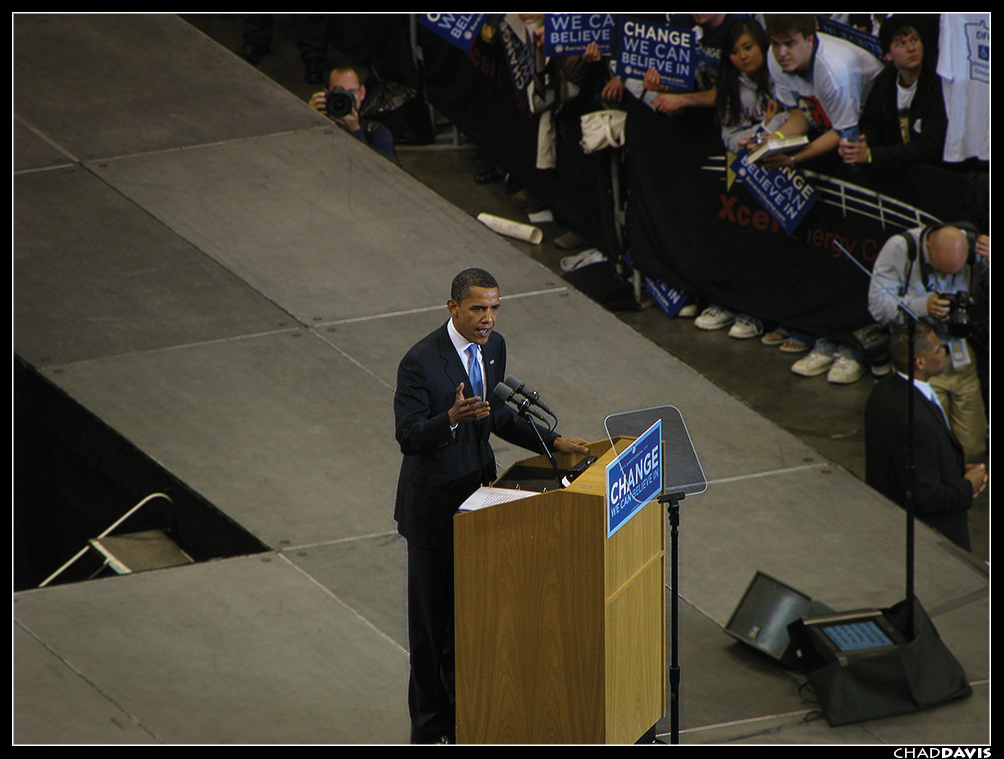
Newscasters and politicians frequently use teleprompters so they can use manuscript delivery but still engage with the audience.
Wikimedia Commons – CC BY-SA 2.0.
You may not even notice them, as the technology has improved to give the illusion that a speaker is engaged with the audience and delivering a speech from memory. The Plexiglas sheets on poles that surround the president during the inauguration and State of the Union addresses are cleverly hidden teleprompters. Even these useful devices can fail. A quick search for “teleprompter fail” on YouTube will yield many examples of politicians and newscasters who probably wish they had a paper backup of their speech. Since most of us will likely not have opportunities to speak using a teleprompter, great care should be taken to ensure that the delivery is effective. To make the delivery seem more natural, print the speech out in a larger-than-typical font, triple-space between lines so you can easily find your place, use heavier-than-normal paper so it’s easy to pick up and turn the pages as needed, and use a portfolio so you can carry the manuscript securely.
Strengths of Manuscript Delivery
- The speaker can include precise or complex information such as statistics or quotes.
- The entire content of the speech is available for reference during the delivery.
- The speech will be consistent in terms of content and time length, which is beneficial if a speech will be delivered multiple times.
Weaknesses of Manuscript Delivery
- Engagement with the audience is challenging, because the speaker must constantly reference the manuscript (unless a teleprompter is used).
- Speakers are unable to adapt information to audience reactions, since they are confined to the content of the manuscript.
- Speakers may be tempted to read the entire speech because they didn’t practice enough or because they get nervous.
- Speakers who are able to make eye contact with the audience may still sound like they are reading the speech unless they employ proper vocal variety, pacing, and pauses.
Memorized Delivery
Completely memorizing a speech and delivering it without notes is known as memorized delivery . Some students attempt to memorize their speech because they think it will make them feel more confident to not have to look at their notes; however, when their anxiety level spikes at the beginning of their speech and their mind goes blank for a minute, many admit they should have chosen a different delivery method. When using any of the other delivery methods, speakers still need to rely on their memory. An impromptu speaker must recall facts or experiences related to their topic, and speakers using a manuscript want to have some of their content memorized so they do not read their entire speech to their audience. The problem with memorized delivery overall is that it puts too much responsibility on our memory, which we all know from experience is fallible.
When memorizing, most people use rote memorization techniques, which entail reading and then reciting something over and over until it is committed to memory. One major downfall of this technique is its effect on speaking rate. When we memorize this way, we end up going over the early parts of a speech many more times than the later parts. As you memorize one sentence, you add on another, and so on. By the time you’re adding on later parts of your speech, you are likely speed talking through the earlier parts because you know them by heart at that point. As we’ll discuss more later, to prevent bad habits from practice from hurting our speech delivery, speakers should practice a speech the exact way they want to deliver it to their audience. Fast-paced speaking during practice will likely make its way into the actual delivery of the speech. Delivery also suffers when speaking from memory if the speaker sounds like he or she is reciting the speech. Rote memorization tasks that many of us had to do in school have left their mark on our memorized delivery. Being made to recite the pledge of allegiance, the preamble to the Constitution, and so on didn’t enhance our speaking abilities. I’ve observed many students whose speeches remind me of the sound of school children flatly going through the motions of reciting the Pledge of Allegiance. It’s the “going through the motions” impression that speakers should want to avoid.

Memorized delivery is a good option for people like tour guides, who need to move while speaking and be interactive with an audience.
John Lambert Pearson – ”listening” to adam – CC BY 2.0.
Even with much practice, our memories can fail. If you do opt to use memorized delivery, make sure you have several “entry points” determined, so you can pick up at spots other than the very beginning of a speech if you lose your place and have to start again. Memorized delivery is very useful for speakers who are going to be moving around during a speech when carrying notes would be burdensome. Think of the tour guide who showed you around your college campus. As someone who used to give college tours, I can attest to the fact that we all had speeches memorized, which was a good thing. It’s already difficult enough to walk backward while facing a group of people and lead them across roads and up stairs. Think about how dangerous it would be if the tour guide were trying to hold onto and reference a stack of note cards at the same time! In summary, I only recommend memorized delivery in cases where the speech is short (only one to two minutes), the speech is personal (like a brief toast), or the speech will be repeated numerous times (like a tour guide’s spiel), and even in these cases, it may be perfectly fine to have notes. Many students think that their anxiety and/or delivery challenges will be fixed if they just memorize their speech only to find that they are more anxious and have more problems.
Strengths of Memorized Delivery
- Speakers can include precise or complex information such as statistics or quotes (if they have put the time into memorization).
- Speakers can directly engage with the audience without worrying about referencing notes.
- The speech will be consistent in terms of content and time-length, which is beneficial if a speech will be delivered multiple times.
Weaknesses of Memorized Delivery
- It is the most time-consuming delivery method.
- Speakers are unable to adapt information to audience reactions, since they are confined to the content they memorized.
- If speakers lose their place in the speech, they will likely have to start over.
- Since everything is preplanned, it is difficult to make the speech content and delivery seem genuine (i.e., humor may seem “canned” or corny).
- The speech can sound like a recitation if the proper vocal variety and pacing are not used.

Extemporaneous Delivery
Extemporaneous delivery entails memorizing the overall structure and main points of a speech and then speaking from keyword/key-phrase notes. This delivery mode brings together many of the strengths of the previous three methods. Since you only internalize and memorize the main structure of a speech, you don’t have to worry as much about the content and delivery seeming stale. Extemporaneous delivery brings in some of the spontaneity of impromptu delivery but still allows a speaker to carefully plan the overall structure of a speech and incorporate supporting materials that include key facts, quotations, and paraphrased information. You can also more freely adapt your speech to fit various audiences and occasions, since every word and sentence isn’t predetermined. This can be especially beneficial when a speech will be delivered multiple times. The minilectures I give in my classes, for example, are good examples of extemporaneous delivery. Even though I’ve presented the basic content of this chapter dozens of times over the years, each presentation has been different, because I can vary the examples and amount of elaboration that I add to the core content that I’ve memorized. For example, I may spend more time discussing speaking anxiety with a class that has expressed more apprehension about public speaking. I also change the example videos I show to connect to ever-changing current events or popular culture.
When preparing a speech that you will deliver extemporaneously, you will want to start practicing your speech early and then continue to practice as you revise your content. Investing quality time and effort into the speech-outlining process helps with extemporaneous delivery. As you put together your outline, you are already doing the work of internalizing the key structure of your speech. Read parts of your outline aloud as you draft them to help ensure they are written in a way that makes sense and is easy for you to deliver. By the time you complete the formal, full-sentence outline, you should have already internalized much of the key information in your speech. Now, you can begin practicing with the full outline. As you become more comfortable with the content of your full outline, start to convert it into your speaking outline. Take out information that you know well and replace it with a keyword or key phrase that prompts your memory. You’ll probably want to leave key quotes, facts, and other paraphrased information, including your verbal source citation information, on your delivery outline so you make sure to include it in your speech. Once you’ve converted your full outline into your speaking outline, practice it a few more times, making sure to take some time between each practice session so you don’t inadvertently start to memorize the speech word for word. The final product should be a confident delivery of a well-organized and structured speech that is conversational and adaptable to various audiences and occasions.
Strengths of Extemporaneous Delivery
- Speech content and delivery appear more spontaneous and natural, making it more conversational, since the speaker is using a keyword/key-phrase outline.
- Speakers can include quotes or complex information on their speaking outline for easy reference.
- Speakers can adapt information and delivery to specific audiences, occasions, and audience reactions, since they are not confined to the content of a manuscript or what they memorized.
Weaknesses of Extemporaneous Delivery
- Since the speech is so adaptable, it can be difficult to ensure the speech will be the exact same length each time.
- It is perhaps not the best option when exact wording is expected.
- Speakers must find a balance between having too much content on their speaking outline, which may cause them to read, and too little content, which may lead to fluency hiccups.
Practicing Your Speech
Practicing a speech is essential, and practice sessions can be more or less useful depending on how you approach them. There are three primary phases to the practice process. In the first phase, you practice as you’re working through your ideas and drafting your outline. In the second, you practice for someone and get feedback. In the third, you put the finishing touches on the speech.
Start practicing your speech early, as you are working through your ideas, by reading sections aloud as you draft them into your working outline. This will help ensure your speech is fluent and sounds good for the audience. Start to envision the audience while you practice and continue to think about them throughout the practicing process. This will help minimize anxiety when you actually have them sitting in front of you. Once you have completed your research and finished a draft of your outline, you will have already practiced your speech several times as you were putting it together. Now, you can get feedback on the speech as a whole.
You begin to solicit feedback from a trusted source in the second phase of practicing your speech. This is the most important phase of practicing, and the one that most speakers do not complete. Beginning speakers may be nervous to practice in front of someone, which is to be expected. But review the strategies for managing anxiety discussed earlier in this chapter and try to face that anxiety. After all, you will have to face a full audience when you deliver the speech, so getting used to speaking in front of someone can only help you at this point. Choose someone who will give you constructive feedback on your speech, not just unconditional praise or criticism. Before you practice for them, explain the assignment or purpose of the speech. When practicing for a classroom speech, you may even want to give the person the assignment guidelines or a feedback sheet that has some key things for them to look for. Ask them for feedback on content and delivery. Almost anyone is good at evaluating delivery, but it’s more difficult to evaluate content. And, in most cases, the content of your speech will be account for more of your grade or what you will be evaluated on for work than the delivery. Also begin to time your speech at this point, so you can determine if it meets any time limits that you have.
In addition to practicing for a trusted source for feedback, you may want to audio or video record your speech. This can be useful because it provides an objective record that you can then compare with the feedback you got from your friend and to your own evaluation of your speech. The most important part of this phase is incorporating the feedback you receive into your speech. If you practice for someone, get feedback, and then don’t do anything with the feedback, then you have wasted your time and their time. Use the feedback to assess whether or not you met your speaking goals. Was your thesis supported? Was your specific purpose met? Did your speech conform to any time limits that were set? Based on your answers to these questions, you may need to make some changes to your content or delivery, so do not put this part of practicing off to the last minute. Once the content has been revised as needed, draft your speaking outline and move on to the next phase of practice.

You can practice your speech in front of a mirror to gauge your use of facial expressions and gestures. In addition, practice in front of a couple people for feedback.
Tschlunder – Mirror – CC BY-NC-ND 2.0.
During the third and final phase of practice, you are putting the finishing touches on your speech. You should be familiar with the content based on your early practice sessions. You have also gotten feedback and incorporated that feedback into the speech. Your practice sessions at this point should precreate, as much as possible, the conditions in which you will be giving your speech. You should have your speaking outline completed so you can practice with it. It’s important to be familiar with the content on your note cards or speaking outline so you will not need to rely on it so much during the actual delivery. You may also want to practice in the type of clothing you will be wearing on speech day. This can be useful if you are wearing something you don’t typically wear—a suit for example—so you can see how it might affect your posture, gestures, and overall comfort level. If possible, at least one practice session in the place you will be giving the speech can be very helpful, especially if it’s a room you are not familiar with. Make sure you’re practicing with any visual aids or technology you will use so you can be familiar with it and it doesn’t affect your speech fluency. Continue to time each practice round. If you are too short or too long, you will need to go back and adjust your content some more. Always adjust your content to fit the time limit; do not try to adjust your delivery. Trying to speed talk or stretch things out to make a speech faster or longer is a mistake that will ultimately hurt your delivery, which will hurt your credibility. The overall purpose of this phase of practicing is to minimize surprises that might throw you off on speech day.
Some “Dos” and “Don’ts” for Effective Speech Practice Sessions
- Do start practicing sections of your speech early, as you draft your outline.
- Do practice for someone for feedback.
- Do time yourself once a draft of the speech is completed and adjust the speech as needed to conform to time limits.
- Do deliver the speech the way you want it to be when you deliver it for your audience (use the rate, volume, vocal variety, pauses, and emphasis you plan to use on speech day).
- Don’t only practice in front of a mirror (practicing once in front of a mirror can help you gauge your facial expressions and other aspects of delivery, but that shouldn’t be the only way you practice).
- Don’t only practice in your head (we have a tendency to go too fast when we practice in our head, and you need to get practice saying the words of your speech to help lessen fluency hiccups).
- Don’t practice too much. It’s best to practice a few times in the days leading up to the speech, making sure to leave several hours between practice sessions. Practicing too much can lead you to become bored with your content, which could lead to delivery that sounds like a recitation.
Key Takeaways
- The four methods of delivering a speech are impromptu, manuscript, memorized, and extemporaneous delivery.
- Impromptu delivery evokes higher levels of speaking anxiety because a speaker has little to no time to prepare the speech; however, this method can increase public speaking skills for people who enjoy thinking on their feet.
- Manuscript delivery entails speaking from a manuscript that contains a word-for-word transcript of your speech. This delivery method can be good for speeches that contain complex information that will be published or quoted but can be challenging because speakers may read their speech, which lessens engagement with the audience.
- Memorized delivery entails speaking from memory. Speakers with a reliable memory will be able to include specific information and engage the audience freely. This method is the most time-consuming delivery option and may come across as a recitation instead of an engaging speech.
- Extemporaneous delivery entails memorizing the general structure of a speech, not every word, and then delivering the speech from a keyword outline. Having the keyword outline allows a speaker to include specific information and references while remaining adaptable to the occasion and audience since every word isn’t planned out.
- Practicing your speech should occur in three phases. First, practice as you are drafting the outline to help you process through your speech ideas. Second, practice for someone and get feedback and record your speech for self-evaluation. Use this feedback to make appropriate changes to your speech. Third, put the finishing touches on the speech: make needed adjustments to the content to meet time limits, become familiar with your speaking outline, and precreate the conditions of speech day for your final few practice sessions.
- Which delivery methods have you used before? Which did you like the best and why? Which delivery method would you most prefer a speaker to use if you were an audience member and why?
- Have you ever had any “surprises” come up during a speech that you could have prevented with more effective practice sessions? If so, explain. If not, list some surprises that good practice sessions could help prevent.
- Using the suggestions in the chapter, make a timeline for practicing your next speech. Include specific dates and make a list of things you plan to do during each of the three phases of practice.
Public Speaking Copyright © 2023 by University of Nebraska at Omaha is licensed under a Creative Commons Attribution-NonCommercial-ShareAlike 4.0 International License , except where otherwise noted.

4 Extemporaneous Speaking: The Basics
Learning Objectives
- Demonstrate an understanding of proper speech delivery by learning the key elements of extemporaneous speaking and the time it will take to deliver the well-developed speech.
Extemporaneous Speaking
Extemporaneous speaking is a fancy way of saying: delivering a well-prepared speech. Extemporaneous speaking is not delivering a monologue or a memorized speech. Public speaking students often fall into the trap of under-preparing and under-practicing their speeches. This results in an, “Oh! no! I am not prepared and now I must read this outline word-for-word and hope for the best.” However, the best does not come to fruition and students that engage in this practice are disappointed when they lose substantial points from their speech grade due to lack of preparation, practice, and reading word-for-word from an outline. Just – don’t – do -it.
Here are a few ways you can engage in extemporaneous speaking:
- Know your speech topic
- Research your topic
- Create a timeline – research, writing, peer-review, practicing, editing, practicing again
- Create note cards to guide your speech
- Practice, practice, practice
- connecting with your audience is key in extemporaneous speaking
Dialogue vs. Monologue
The first tenet of the dialogic perspective is that communication should be a dialogue and not a monologue. Lev Yakubinsky argued that even public speaking situations often turn into dialogues when audience members actively engage speakers by asking questions. He even claimed that nonverbal behavior (e.g., nodding one’s head in agreement or scowling) functions as feedback for speakers and contributes to a dialogue (Yakubinsky, 1997). Overall, if you approach your public speaking experience as a dialogue, you’ll be more actively engaged as a speaker and more attentive to how your audience is responding, which will, in turn, lead to more actively engaged audience members.
Build a Proper Timeline
- To ensure you have enough time for the assignment, create a timeline that works for your schedule
- Week 1 – Brainstorm your speech topic and conduct an audience analysis
- Week 2 – Research, gather support, plan outline, and write a speech
- Week 3 – Edit, peer-review, begin practicing your speech
- Week 4 – Revise, practice, create note cards, create a visual aid, and refine your delivery
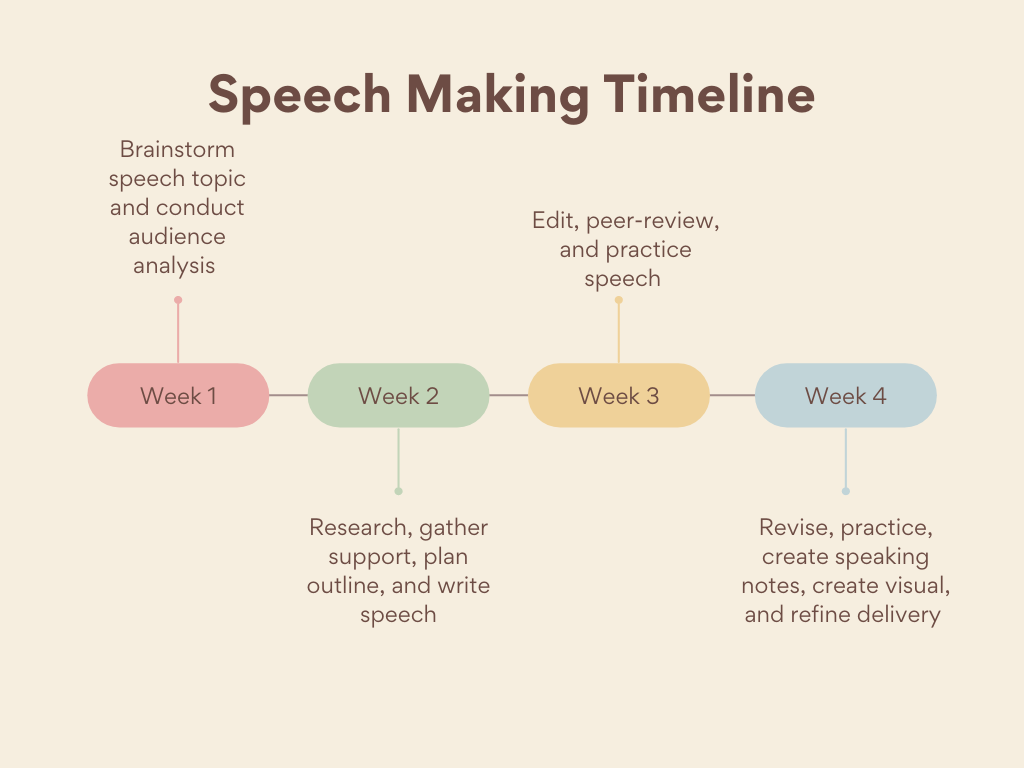
Building on This Information
As you progress through this course, you will revisit proper extemporaneous speaking, the use of outlining, proper use of notecards, and delivering a strong speech. It is important to note that your audience deserves a speech that is interesting, thoughtful, and well-rehearsed. The audience is listening to you as the credible speaker in the room; in order to remain credible and professional, you will want to deliver an extemporaneous speech.
Key Takeaways
Students will want to become familiar with extemporaneous speaking in order to work towards a speech delivery that relies on effective speech strategies and not reading word-for-word from an outline.
- Extemporaneous speaking is a skill that public speaking students must hone in on before delivering their speech to an audience.
- Students will want to plan ahead to deliver a strong speech in the informative and persuasive speech weeks of this course.
- Creating a proper timeline will assist in delivering a well-developed extemporaneous speech.
Public Speaking Copyright © by Dr. Layne Goodman; Amber Green, M.A.; and Various is licensed under a Creative Commons Attribution-NonCommercial-ShareAlike 4.0 International License , except where otherwise noted.
Share This Book

- school Campus Bookshelves
- menu_book Bookshelves
- perm_media Learning Objects
- login Login
- how_to_reg Request Instructor Account
- hub Instructor Commons
Margin Size
- Download Page (PDF)
- Download Full Book (PDF)
- Periodic Table
- Physics Constants
- Scientific Calculator
- Reference & Cite
- Tools expand_more
- Readability
selected template will load here
This action is not available.

7.02: Chapter 33: Methods of Speech Delivery
- Last updated
- Save as PDF
- Page ID 134500
\( \newcommand{\vecs}[1]{\overset { \scriptstyle \rightharpoonup} {\mathbf{#1}} } \)
\( \newcommand{\vecd}[1]{\overset{-\!-\!\rightharpoonup}{\vphantom{a}\smash {#1}}} \)
\( \newcommand{\id}{\mathrm{id}}\) \( \newcommand{\Span}{\mathrm{span}}\)
( \newcommand{\kernel}{\mathrm{null}\,}\) \( \newcommand{\range}{\mathrm{range}\,}\)
\( \newcommand{\RealPart}{\mathrm{Re}}\) \( \newcommand{\ImaginaryPart}{\mathrm{Im}}\)
\( \newcommand{\Argument}{\mathrm{Arg}}\) \( \newcommand{\norm}[1]{\| #1 \|}\)
\( \newcommand{\inner}[2]{\langle #1, #2 \rangle}\)
\( \newcommand{\Span}{\mathrm{span}}\)
\( \newcommand{\id}{\mathrm{id}}\)
\( \newcommand{\kernel}{\mathrm{null}\,}\)
\( \newcommand{\range}{\mathrm{range}\,}\)
\( \newcommand{\RealPart}{\mathrm{Re}}\)
\( \newcommand{\ImaginaryPart}{\mathrm{Im}}\)
\( \newcommand{\Argument}{\mathrm{Arg}}\)
\( \newcommand{\norm}[1]{\| #1 \|}\)
\( \newcommand{\Span}{\mathrm{span}}\) \( \newcommand{\AA}{\unicode[.8,0]{x212B}}\)
\( \newcommand{\vectorA}[1]{\vec{#1}} % arrow\)
\( \newcommand{\vectorAt}[1]{\vec{\text{#1}}} % arrow\)
\( \newcommand{\vectorB}[1]{\overset { \scriptstyle \rightharpoonup} {\mathbf{#1}} } \)
\( \newcommand{\vectorC}[1]{\textbf{#1}} \)
\( \newcommand{\vectorD}[1]{\overrightarrow{#1}} \)
\( \newcommand{\vectorDt}[1]{\overrightarrow{\text{#1}}} \)
\( \newcommand{\vectE}[1]{\overset{-\!-\!\rightharpoonup}{\vphantom{a}\smash{\mathbf {#1}}}} \)
Chapter 33: Methods of Speech Delivery
Rebekah bennetch, corey owen, and zachary keesey.
Learning Objectives
By the end of this chapter, you should be able to:
- Distinguish between four methods of speech delivery: the impromptu speech, the manuscript speech, the memorized speech, and the extemporaneous speech
- Explain the advantages and disadvantages of the four types of speeches
- Explain why an extemporaneous is the preferred delivery style when using rhetorical theory
Key Terms and Concepts
- extemporaneous
We have established that presentations involve much more than the transfer of information. Sure, you could treat a presentation as an opportunity to simply read a report you’ve written out loud to a group, but you would fail to both engage your audience and make a connection with them. In other words, you would leave them wondering exactly why they had to listen to your presentation instead of reading it at their leisure.
The Four Methods of Speech Delivery
One of the ways to ensure that you engage your audience effectively is by carefully considering how best to deliver your speech. Each of you has sat in a class, presentation, or meeting where you didn’t feel interested in the information the presenter was sharing. Part of the reason for your disengagement likely originated in the presenter’s method of speech delivery.
For our purposes, there are four different methods—or types—of speech delivery in technical communication:
- Extemporaneous
Exercise #1: The Four Methods of Speech Delivery
What comes to mind when you think about the four methods of speech delivery? How do you think they are different from one another? Have you given a speech using any of these methods before?
Watch the video below for a brief overview of each one. After you are finished, answer the questions below.

A YouTube element has been excluded from this version of the text. You can view it online here: https://pb.libretexts.org/effective/?p=159
- Which method are you most comfortable with? Why?
- Which method are you the least comfortable with? Why?
- Which method do you think is the best for connecting with your audience? Why?
The public speaking section of this course will require you to deliver a speech using an extemporaneous style, but let’s take a look at how all four differ in approach:
Impromptu Speeches
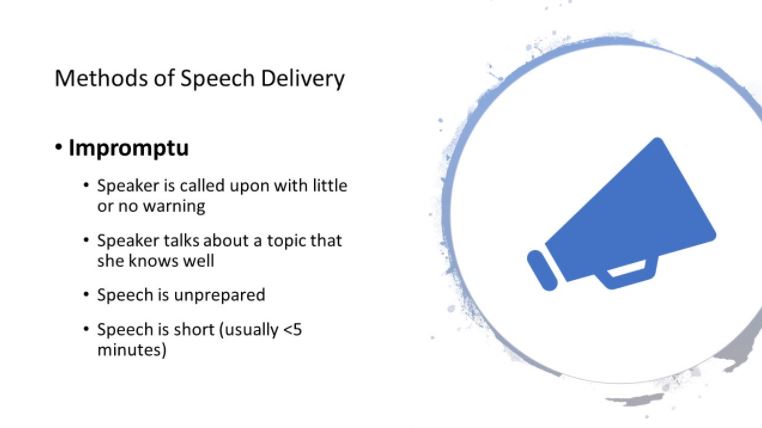
Impromptu speaking is the presentation of a short message without advanced preparation. You have probably done impromptu speaking many times in informal, conversational settings. Self-introductions in group settings are examples of impromptu speaking: “Hi, my name is Shawnda, and I’m a student at the University of Saskatchewan.”
Another example of impromptu speaking occurs when you answer a question such as, “What did you think of the movie?” Your response has not been preplanned, and you are constructing your arguments and points as you speak. Even worse, you might find yourself going into a meeting when your boss says, “I want you to talk about the last stage of the project” with no warning.
The advantage of this kind of speaking is that it’s spontaneous and responsive in an animated group context. The disadvantagv e is that the speaker is gi en little or no time to contemplate the central theme of their message. As a result, the message may be disorganized and difficult for listeners to follow.
Here is a step-by-step guide that may be useful if you are called upon to give an impromptu speech in public:
- Take a moment to collect your thoughts and plan the main point that you want to make (like a mini thesis statement).
- Thank the person for inviting you to speak. Do not make comments about being unprepared, called upon at the last moment, on the spot, or uneasy. In other words, try to avoid being self-deprecating!
- Deliver your message, making your main point as briefly as you can while still covering it adequately and at a pace your listeners can follow.
- If you can use a structure, use numbers if possible: “Two main reasons. . .” or “Three parts of our plan. . .” or “Two side effects of this drug. . .” Past, present, and future or East Coast, Midwest, and West Coast are pre-fab structures.
- Thank the person again for the opportunity to speak.
- Stop talking. It is easy to “ramble on” when you don’t have something prepared. If in front of an audience, don’t keep talking as you move back to your seat.
Impromptu speeches are generally most successful when they are brief and focus on a single point.
We recommend practicing your impromptu speaking regularly. Do you want to work on reducing your vocalized pauses in a formal setting? Great! You can begin that process by being conscious of your vocalized fillers during informal conversations and settings.
Exercise #2: Impromptu Speech Example
Below are two examples of an impromptu speech. In the first video, a teacher is demonstrating an impromptu speech to his students on the topic of strawberries. He quickly jots down some notes before presenting.
What works in his speech? What could be improved?

Link to Original Video: tinyurl.com/impromptuteacher
In the above example, the teacher did a decent job considering how little time he had to prepare. In this next example, you will see just how badly an impromptu speech can go. It is a video of a best man speech at a wedding. Keep in mind that the speaker is the groom’s brother.
Is there anything that he does well? What are some problems with his speech?

Link to Original Video: tinyurl.com/badimpromptubestman
Manuscript Speeches
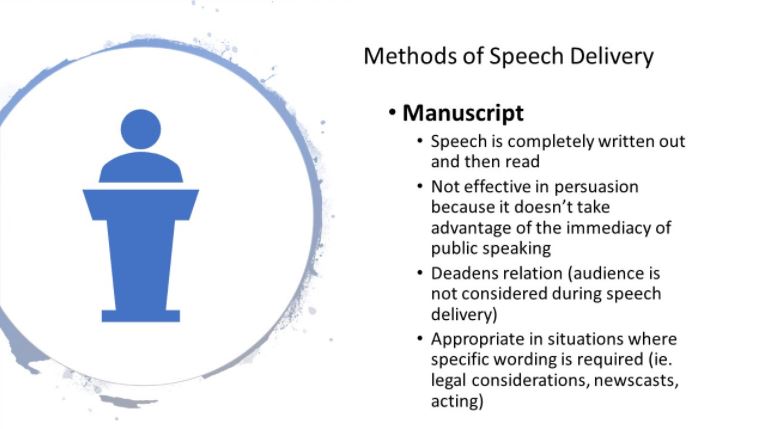
Manuscript speaking is the word-for-word iteration of a written message. In a manuscript speech, the speaker maintains their attention on the printed page except when using presentation aids.
The advantage to reading from a manuscript is the exact repetition of original words. This can be extremely important in some circumstances. For example, reading a statement about your organization’s legal responsibilities to customers may require that the original words be exact. In reading one word at a time, in order, the only errors would typically be the mispronunciation of a word or stumbling over complex sentence structure. A manuscript speech may also be appropriate at a more formal affair (like a funeral), when your speech must be said exactly as written in order to convey the proper emotion the situation deserves.
However, there are costs involved in manuscript speaking. First, it’s typically an uninteresting way to present. Unless the speaker has rehearsed the reading as a complete performance animated with vocal expression and gestures (well-known authors often do this for book readings), the presentation tends to be dull. Keeping one’s eyes glued to the script prevents eye contact with the audience. For this kind of “straight” manuscript speech to hold audience attention, the audience must be already interested in the message and speaker before the delivery begins. Finally, because the full notes are required, speakers often require a lectern to place their notes, restricting movement and the ability to engage with the audience. Without something to place the notes on, speakers have to manage full-page speaking notes, and that can be distracting.
It is worth noting that professional speakers, actors, news reporters, and politicians often read from an autocue device such as a teleprompter. This device is especially common when these people appear on television where eye contact with the camera is crucial. With practice, a speaker can achieve a conversational tone and give the impression of speaking extemporaneously and maintaining eye contact while using an autocue device. However, success in this medium depends on two factors:
- the speaker is already an accomplished public speaker who has learned to use a conversational tone while delivering a prepared script, and
- the speech is written in a style that sounds conversational.
Exercise #3: Manuscript Speech Example
Below is a video that shows an example of a manuscript speech. In the video, US Presidential Historian, Doris Kearns Goodwin, gives a speech about different US presidents.
What works in her speech? What could be improved?

Link to Original Video: tinyurl.com/goodwindepauw
Memorized Speeches
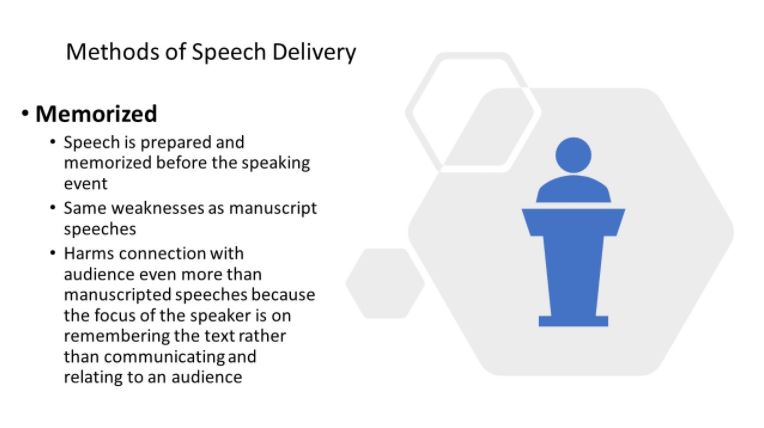
Memorized speaking is reciting a written message that the speaker has committed to memory. Actors, of course, recite from memory whenever they perform from a script in a stage play, television program, or movie. When it comes to speeches, memorization can be useful when the message needs to be exact and the speaker doesn’t want to be confined by notes.
The advantage to memorization is that it enables the speaker to maintain eye contact with the audience throughout the speech. Being free of notes means that you can move freely around the stage and use your hands to make gestures. If your speech uses presentation aids, this freedom is even more of an advantage.
Memorization, however, can be tricky. First, if you lose your place and start trying to ad lib, the contrast in your style of delivery will alert your audience that something is wrong. If you go completely blank during the presentation, it will be extremely difficult to find your place and keep going. Obviously, memorizing a typical seven-minute classroom speech takes a great deal of time and effort, and if you aren’t used to memorizing, it is very difficult to pull off.
Exercise #4: Memorized Speech Example
Below is a video that shows an example of a memorized speech. In the video, former Louisiana governor, Bobby Jindal, responds to Barack Obama’s State of the Union address back in 2009.
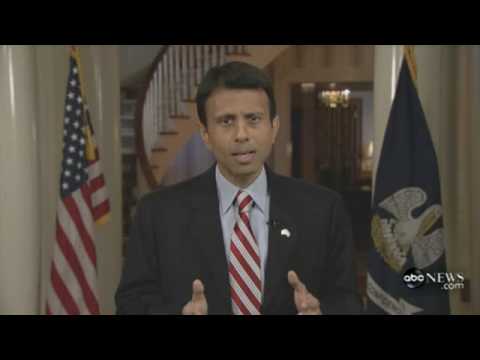
Extemporaneous Speeches

Extemporaneous speaking is the presentation of a carefully planned and rehearsed speech, spoken in a conversational manner using brief notes.
Speaking extemporaneously has some advantages. It promotes the likelihood that you, the speaker, will be perceived as knowledgeable and credible since you know the speech well enough that you don’t need to read it. In addition, your audience is likely to pay better attention to the message because it is engaging both verbally and nonverbally. By using notes rather than a full manuscript (or everything that you’re going to say), the extemporaneous speaker can establish and maintain eye contact with the audience and assess how well they are understanding the speech as it progresses. It also allows flexibility; you are working from the strong foundation of an outline, but if you need to delete, add, or rephrase something at the last minute or to adapt to your audience, you can do so. The outline also helps you be aware of main ideas vs. subordinate ones.
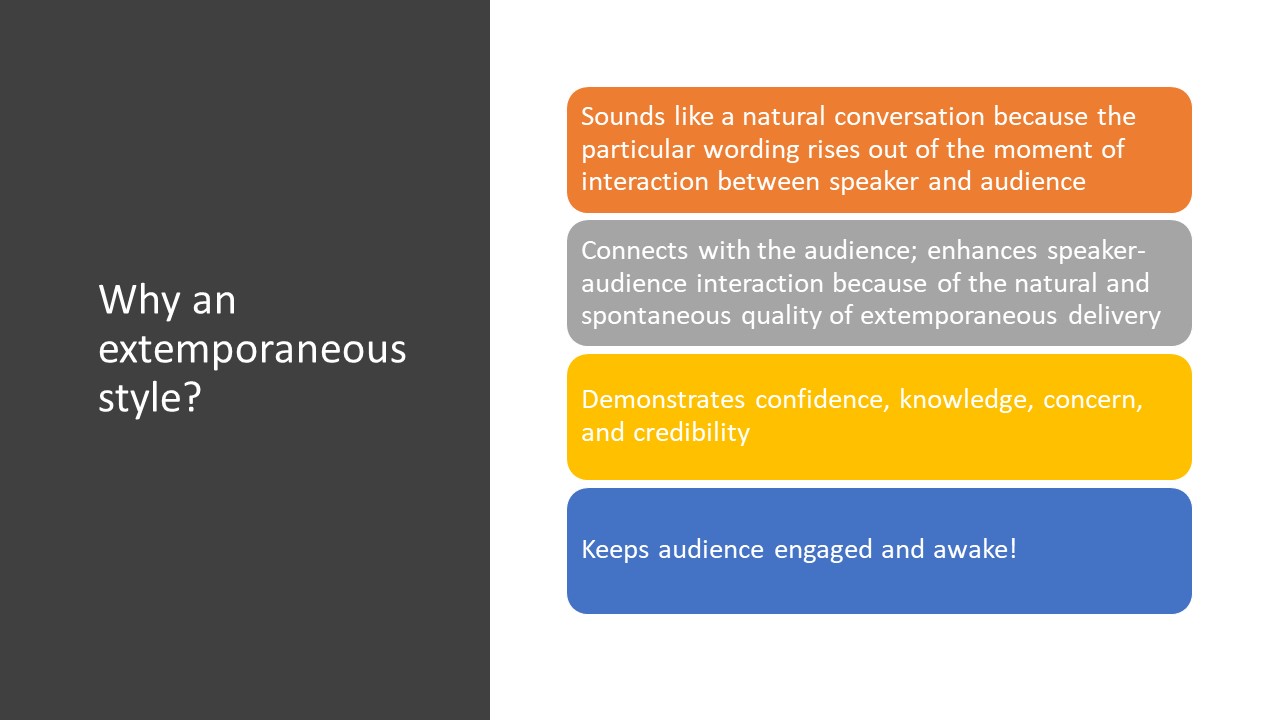
Compared to the other three types of speech delivery, an extemporaneous style is the best for engaging your audience and making yourself sound like a natural speaker. The video below provides some tips on how to deliver a speech using this method.
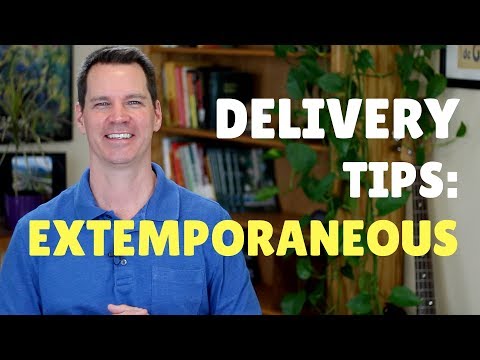
Link to Original Video: tinyurl.com/deliverextempres
The slide below provides a brief overview of tips for preparing your extemporaneous presentation.
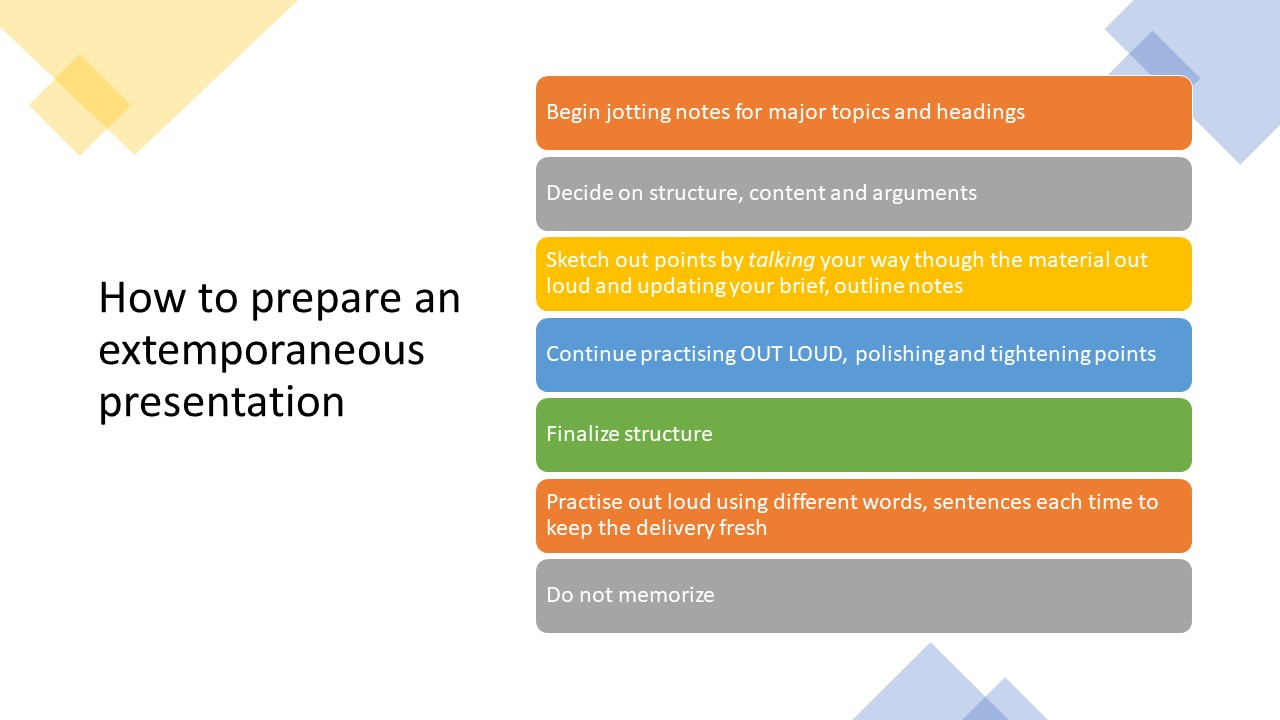
Exercise# 5: Extemporaneous Speech Example
Below is a video that shows an example of an extemporaneous speech. In the video, a former University of Saskatchewan student tries to persuade her peers to spend more solo time outside.

Link to Original Video: tinyurl.com/rcm401speech
Key Takeaways
- When designing any speech, it’s important to consider how you will deliver that speech. In technical communication, there are four different types of speech delivery, each with their advantages and disadvantages. They are: impromptu , manuscript , memorized , and extemporaneous .
- An impromptu speech can take many forms such as a toast at a wedding, being asked to give a project update at a meeting, or even simply meeting someone for the first time. While this type of speech can be spontaneous and responsive, the speaker generally has little to no warning that they will need to speak.
- A manuscript speech is completely written out and read word for word. It is often a good style when you want to nail the specific wording and do not want to make an error. However, this type of speech is not very persuasive because it does not take advantage of the immediacy of public speaking. It also completely removes audience relation from the process.
- A memorized speech is when a speaker commits an entire speech to memory. This style also harms relation with the audience because the speaker is more focused on remembering the text of the speech rather than communicating with the audience. Additionally, if you lose your place and need to ad lib, it may be obvious to your audience.
- An extemporaneous speech is done in a natural, conversational speaking style. While it is carefully planned, it is never completely written out like a manuscript. It is also not read or memorized . Instead, an outline is used to help guide the speaker. As a result, more attention can be paid to the audience, allowing the speaker to better connect with them and make adjustments as necessary. This is the style we want you to use for your presentation assignment in RCM 200.
Attributions
This chapter is adapted from “ Communication for Business Professionals ” by eCampusOntario (on Open Library ). It is licensed under Creative Commons Attribution-ShareAlike 4.0 International License .
This chapter is also adapted from “ Speak Out, Call In: Public Speaking as Advocacy ” by Meggie Mapes (on Pressbooks ). It is licensed under a Creative Commons Attribution-NonCommercial-ShareAlike 4.0 International License .
PRDV008: Preparing and Delivering Presentations
Extemporaneous speeches.
Read this article, which summarizes the basics of extemporaneous presentations, as compared to impromptu speeches.
Extemporaneous, the most natural method of delivery, involves glancing at notes while maintaining crucial eye contact with the audience.
Key Takeaways
- There are two popular methods for organizing ideas to create a graphical representation for speaker notes – outlining and mind or concept mapping .
- An outline is a list of items with each item divided into additional sub-items. Each level in an outline has at least two subcategories. There are three basic types of hierarchical outlines – sentence , topic and phrase .
- Topic and phrase are the most useful for speaker notes since they allow the speaker to quickly glance at the notes while maintaining eye contact with the audience.
- Mind mapping and concept mapping are visual representation of ideas and concepts. Both mind maps and concept maps can be used to graphically show the relationship between ideas for a speech and as speaker notes for delivery.
- A mind map diagram starts with a single word as a central branch node and lesser categories as sub-branches going off from the central node. A concept maps can have multiple hubs or nodes with clusters of concepts labeled to show the kind of relationship.
- While extemporaneous speaking may be free of the constraints of memorization and manuscript speaking, it is not careless talk; the speaker prepares notes in advance to deliver an organized speech.
- Concept Map : A diagram showing the relationships among concepts, with the concepts drawn in rectangular boxes, which are connected with labelled arrows that denote the relationships between concepts, such as "is a", "gives rise to", "results in", "is required by", or "contributes to".
- Mind Map : A diagram used to represent words, ideas, tasks or other items linked to and arranged radially around a central key word or idea.
- Extemporaneous : A type of speech delivery which involves preparation of speaker notes prior to delivery, associated with conversational style of delivery.
Extemporaneous Speech
Extemporaneous speaking is one of the most natural methods for delivering a prepared speech. You can use an extemporaneous speech to achieve a more natural tone, flow, and style with the audience.
First, think about your topics and anticipate the audience's reception to your speech. You can develop speech notes based on this preparation and use them to aid you during the presentation.
Preparing Speech Notes
There are two popular methods for creating a graphical representation for notes: outlining, and mind or concept mapping.
An outline is a list of items with each item divided into additional sub-items. Each level in an outline has at least two subcategories. There are three basic types of outlines:
- Sentence outline – Each complete sentence includes a heading or single sentence about the subject of the outline.
- Topic outline – Each topic is listed and functions as a subtopic of the outline's subject.
- Phrase outline – Each short phrase entry is a subtopic of the aforementioned main entry.
Speaking notes, topic outlines, and phrase outlines have an advantage over sentence outlines. For example, you can easily look at your notes for reference and as a personal reminder of which topics to discuss as you're speaking.
Outlines commonly take two forms: alphanumeric and decimal.
Alphanumeric Outline
An alphanumeric outline includes a capitalized number or letter at the beginning of each topic. Look at the sample:
I. Thesis statement: Email and internet monitoring is an invasion of employees' rights
Decimal Outline
The decimal outline shows how each item at every level relates to the whole sample.
Thesis statement:
1.0 Introduction
….1.1 Brief history of Liz Claiborne
….1.2 Corporate environment
2.0 Career opportunities
….2.1 Operations management
……..2.1.1 Traffic
……..2.1.2 International trade and corporate customs
……..2.1.3 Distribution
….2.2 Product development
The outline could be printed or handwritten as in this expert from Richard Nixon's Checkers speech.

Speech Notes : Notes from Richard Nixon's Checkers speech.
Mind Mapping and Concept Mapping
Mind mapping and concept mapping are visual representations of ideas and concepts. A mind map is a diagram that starts with a single word and then branches out from the central node, with lesser categories as sub-branches of the larger branches. Concept maps are more freeform, since multiple hubs and clusters can be created. Unlike mind maps, concept maps do not fix on a single conceptual center.
For example, in the mind map for student learning, you can view the main component idea and related ideas which connect to its branch nodes. You can also use a mind map as speaking notes.
Mind Map : A mind map is a diagram that starts with one word and expands into additional categories.
Practice and Rehearsal Guidelines
The following guidelines are best practices on how to practice and rehearse an extemporaneous speech:
- Speak in a conversational style by pretending you are with your audience.
- Rehearse with your graphics and coordinate them with your talk.
- Display your graphics only when you are talking about them.
- Rehearse in front of others and solicit feedback.
- Record and listen to your timed practice speech.
- Prepare for interruptions and questions at the end.
Although extemporaneous speaking may not require memorization and manuscript speaking, organize and prepare your content and notes ahead of time to deliver a speech that will be well received by your audience.
Free Speech : "Free speech doesn't mean careless talk!" produced by the Office for Emergency Management.


COMMENTS
• Extemporaneous speech: A well-prepared speech that relies on research, clear organization, and practiced delivery, but is neither read nor memorized. What is an Extemporaneous Speech? The word extemporaneous means “without planning” and is considered a synonym for the word impromptu.
Extemporaneous. The last method of delivery we’ll look at is extemporaneous. When speaking extemporaneously, speakers prepare some notes in advance that help trigger their memory of what they planned to say. These notes are often placed on notecards. A 4”x6” notecard or 5”x7” size card works well.
Extemporaneous delivery is the presentation of a carefully planned and rehearsed speech, spoken in a conversational manner using brief notes. By using notes rather than a full manuscript, the extemporaneous speaker can establish and maintain eye contact with the audience and assess how well they understand the speech as it progresses.
Extemporaneous Delivery. Extemporaneous delivery entails memorizing the overall structure and main points of a speech and then speaking from keyword/key-phrase notes. This delivery mode brings together many of the strengths of the previous three methods.
Extemporaneous speaking is a fancy way of saying: delivering a well-prepared speech. Extemporaneous speaking is not delivering a monologue or a memorized speech. Public speaking students often fall into the trap of under-preparing and under-practicing their speeches.
Kris Barton & Barbara G. Tucker. Florida State University & University of Georgia via GALILEO Open Learning Materials. What follows are four methods of delivery that can help you balance between too much and too little formality when giving a speech.
extemporaneous. We have established that presentations involve much more than the transfer of information. Sure, you could treat a presentation as an opportunity to simply read a report you’ve written out loud to a group, but you would fail to both engage your audience and make a connection with them.
Extemporaneous: A type of speech delivery which involves preparation of speaker notes prior to delivery, associated with conversational style of delivery. Extemporaneous Speech. Extemporaneous speaking is one of the most natural methods for delivering a prepared speech.